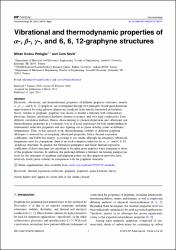| dc.contributor.author | Perkgöz, Nihan Kosku | |
| dc.contributor.author | Sevik, Cem | |
| dc.date.accessioned | 2019-10-21T20:12:13Z | |
| dc.date.available | 2019-10-21T20:12:13Z | |
| dc.date.issued | 2014 | |
| dc.identifier.issn | 0957-4484 | |
| dc.identifier.issn | 1361-6528 | |
| dc.identifier.uri | https://dx.doi.org/10.1088/0957-4484/25/18/185701 | |
| dc.identifier.uri | https://hdl.handle.net/11421/20427 | |
| dc.description | WOS: 000334363600007 | en_US |
| dc.description | PubMed ID: 24737253 | en_US |
| dc.description.abstract | Electronic, vibrational, and thermodynamic properties of different graphyne structures, namely alpha-, ss-, gamma-, and 6, 6, 12-graphyne, are investigated through first principles- based quasi-harmonic approximation by using phonon dispersions predicted from density- functional perturbation theory. Similar to graphene, graphyne was shown to exhibit a structure with extraordinary electronic features, mechanical hardness, thermal resistance, and very high conductivity from different calculation methods. Hence, characterizing its phonon dispersions and vibrational and thermodynamic properties in a systematic way is of great importance for both understanding its fundamental molecular properties and also figuring out its phase stability issues at different temperatures. Thus, in this research work, thermodynamic stability of different graphyne allotropes is assessed by investigating vibrational properties, lattice thermal expansion coefficients, and Gibbs free energy. According to our results, although the imaginary vibrational frequencies exist for ss-graphyne, there is no such a negative behavior for alpha-, ss-, gamma-, and 6, 6, 12-graphyne structures. In general, the Gruneisen parameters and linear thermal expansion coefficients of these structures are calculated to be rather more negative when compared to those of the graphene structure. In addition, the predicted difference between the binding energies per atom for the structures of graphene and graphyne points out that graphyne networks have relatively lower phase stability in comparison with the graphene structures. | en_US |
| dc.description.sponsorship | Scientific and Technological Research Council of Turkey [TUBITAK 113F096]; Anadolu University [BAP-1306F261, BAP-1306F174] | en_US |
| dc.description.sponsorship | We would like to thank the ULAKBIM High Performance and Grid Computing Center for a sufficient time allocation for our projects. CS particularly acknowledges the support from the Scientific and Technological Research Council of Turkey (TUBITAK 113F096) and Anadolu University (BAP-1306F261) for this project. NKP particularly acknowledges the support from Anadolu University (BAP-1306F174) for this project. | en_US |
| dc.language.iso | eng | en_US |
| dc.publisher | IOP Publishing LTD | en_US |
| dc.relation.isversionof | 10.1088/0957-4484/25/18/185701 | en_US |
| dc.rights | info:eu-repo/semantics/openAccess | en_US |
| dc.subject | Thermal Expansion Coefficient | en_US |
| dc.subject | Graphene | en_US |
| dc.subject | Graphyne | en_US |
| dc.subject | Quasi Harmonic Theory | en_US |
| dc.title | Vibrational and thermodynamic properties of alpha-, ss-, gamma-, and 6, 6, 12-graphyne structures | en_US |
| dc.type | article | en_US |
| dc.relation.journal | Nanotechnology | en_US |
| dc.contributor.department | Anadolu Üniversitesi, Mühendislik Fakültesi, Elektrik ve Elektronik Mühendisliği Bölümü | en_US |
| dc.identifier.volume | 25 | en_US |
| dc.identifier.issue | 18 | en_US |
| dc.relation.publicationcategory | Makale - Uluslararası Hakemli Dergi - Kurum Öğretim Elemanı | en_US |
| dc.contributor.institutionauthor | Sevik, Cem | |


















